Author Archives: chentsch
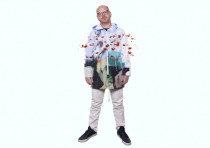
“PartsPartsParts (AR Shirts)” by Miles Peyton
“Miles Peyton brings his already-praised project PartsPartsParts into a new dimension by translating a website into a clothing item. The Pittsburgh-based artist’s webpage of the same name features small cut-out photos of anonymous body parts, which visitors can move around their screens.”

“PartsPartsParts (AR Shirts)” by Miles Peyton
“Miles Peyton brings his already-praised project PartsPartsParts into a new dimension by translating a website into a clothing item. The Pittsburgh-based artist’s webpage of the same name features small cut-out photos of anonymous body parts, which visitors can move around their screens.”

“Stonemilker” by Bjork (2015)
“Björk is among the first musicians to employ virtual reality as a medium. Debuted in March at MoMA PS1 and select record stores, the first installment of Björk-reality arrived as a 360º music video for “Stonemilker,” the opening track off her newest album, Vulnicura(One Little Indian). Just this past week, Björk released the music video on the web, which you can now view thanks to YouTube’s 360º video.”

“Stonemilker” by Bjork (2015)
“Björk is among the first musicians to employ virtual reality as a medium. Debuted in March at MoMA PS1 and select record stores, the first installment of Björk-reality arrived as a 360º music video for “Stonemilker,” the opening track off her newest album, Vulnicura(One Little Indian). Just this past week, Björk released the music video on the web, which you can now view thanks to YouTube’s 360º video.”
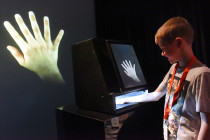
“Augmented Hand Series” by Golan Levin, Chris Sugrue, and Kyle McDonald
“…a real-time interactive software system that presents playful, dreamlike, and uncanny transformations of its visitors’ hands. It consists of a box into which the visitor inserts their hand, and a screen which displays their ‘reimagined’ hand—for example, with an extra finger, or with fingers that move autonomously.”

“Augmented Hand Series” by Golan Levin, Chris Sugrue, and Kyle McDonald
“…a real-time interactive software system that presents playful, dreamlike, and uncanny transformations of its visitors’ hands. It consists of a box into which the visitor inserts their hand, and a screen which displays their ‘reimagined’ hand—for example, with an extra finger, or with fingers that move autonomously.”
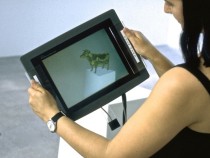
“The Golden Calf” by Jeffrey Shaw (1994)
“This work is constituted by a white pedestal on which there stands an LCD colour monitor connected to computing machinery by a cable running through the pedestal. The viewer of this work picks up and holds this monitor in his hands. The screen shows a representation of the pedestal with a computer-generated image of a golden calf on top. By moving the monitor around the actual pedestal the viewer can examine this golden calf from above and below and all sides. Thus the monitor functions like a window that reveals a virtual body apparently located physically in the real space.”

“The Golden Calf” by Jeffrey Shaw (1994)
“This work is constituted by a white pedestal on which there stands an LCD colour monitor connected to computing machinery by a cable running through the pedestal. The viewer of this work picks up and holds this monitor in his hands. The screen shows a representation of the pedestal with a computer-generated image of a golden calf on top. By moving the monitor around the actual pedestal the viewer can examine this golden calf from above and below and all sides. Thus the monitor functions like a window that reveals a virtual body apparently located physically in the real space.”
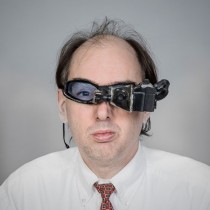
“Eyetap” by Steve Mann (1999)
“Steve Mann, a pioneer of wearable computers and a professor at the University of Toronto who had worn “a computer vision system of some kind for 34 years,”

“Eyetap” by Steve Mann (1999)
“Steve Mann, a pioneer of wearable computers and a professor at the University of Toronto who had worn “a computer vision system of some kind for 34 years,”
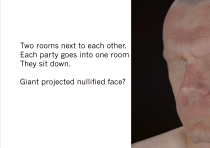
“TBA” by Daniel Pillis, Yousuf Soliman, Claire Hentschker, Dan Sakamoto
Google Docs – via Iframely We are proposing an design fiction installation which allows participants to experience an updated vision of the dystopias presented in science fiction stories like Vonnegut’s “Harrison Bergeron”. Viewing current models of remote communication as

“TBA” by Daniel Pillis, Yousuf Soliman, Claire Hentschker, Dan Sakamoto
Google Docs – via Iframely We are proposing an design fiction installation which allows participants to experience an updated vision of the dystopias presented in science fiction stories like Vonnegut’s “Harrison Bergeron”. Viewing current models of remote communication as
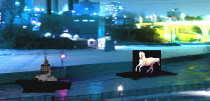
“Nightmare” by Andréa Stanislav, (2011)
YouTube / Dirk Dantuma – via Iframely “…a public video work that creates the illusion of a white horse galloping on the Mississippi, at night, and in slow motion.” more info here…

“Nightmare” by Andréa Stanislav, (2011)
YouTube / Dirk Dantuma – via Iframely “…a public video work that creates the illusion of a white horse galloping on the Mississippi, at night, and in slow motion.” more info here…
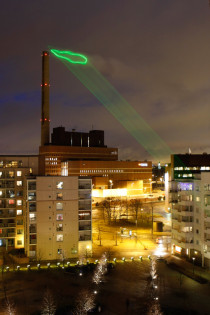
“Pollstream – Nuage Vert” by Helen Evans & Heiko Hansen, (2008)
Projection onto clouds as a symbol of environmental pollution caused by carbon emissions. More info here…

“Pollstream – Nuage Vert” by Helen Evans & Heiko Hansen, (2008)
Projection onto clouds as a symbol of environmental pollution caused by carbon emissions. More info here…
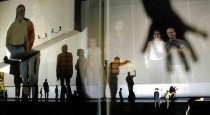
“Body Movies” by Rafael Lozano-Hemmer, (2001)
“Thousands of portraits, taken on the streets of the cities where the project is shown, are projected on a giant screen or façade using elevated robotically-controlled projectors. However, the portraits are completely washed out by powerful xenon light sources

“Body Movies” by Rafael Lozano-Hemmer, (2001)
“Thousands of portraits, taken on the streets of the cities where the project is shown, are projected on a giant screen or façade using elevated robotically-controlled projectors. However, the portraits are completely washed out by powerful xenon light sources
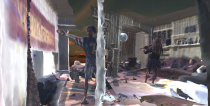
“Our House” by Claire Hentschker (2015)
“Our house” is an interactive virtual environment made from staged and 3D scanned sections of a house on Beacon st. This was made using 123d catch, a structure scanner, and unity 3D. The environment can be downloaded and explored here…

“Our House” by Claire Hentschker (2015)
“Our house” is an interactive virtual environment made from staged and 3D scanned sections of a house on Beacon st. This was made using 123d catch, a structure scanner, and unity 3D. The environment can be downloaded and explored here…
